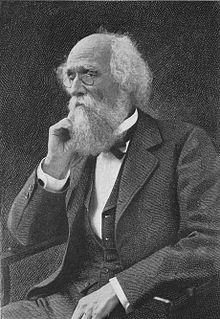Joseph LeConte (geologist)
Joseph LeConte , also Joseph Le Conte , (born February 26, 1823 in Liberty County , Georgia , † July 6, 1901 in Yosemite Valley ) was an American geologist and naturalist.
Life
He came from a respected, originally Huguenot family and studied at Franklin College in Athens (Georgia) with a degree in 1841 and then medicine at the New York College of Physicians and Surgeons (today's Medical School of Columbia University ) with a degree in 1845. He practiced four years as a doctor in Macon (Georgia) , but then decided to study natural history at Harvard University with the famous naturalist Louis Agassiz . An excursion with Agassiz and the state geologist James Hall to the Helderberg layer stage near Albany (New York) , which unlocked layers from the Ordovician and Devonian, encouraged him to become a geologist. He accompanied Agassiz to Florida in 1851 to study coral reefs and was then professor of natural history at Oglethorpe University in Midway (Georgia) and from 1852 to 1856 at Franklin College, his alma mater. From 1857 to 1869 he was professor of chemistry and geology at South Carolina College . During the Civil War he was on the side of the southern states, continued teaching, worked as a doctor and in the manufacture of explosives. Since he found the conditions after the Civil War in the reconstruction era unbearable in the southern states and could not overcome racial prejudice against blacks, he moved to California in 1869 , where he became a physics professor at the newly founded University of California, Berkeley . Soon afterwards he became the first professor of geology and natural history there, which he remained until his death. He is buried in Mountain View Cemetery in Oakland, California .
In addition to geology, he also published on physiological optics and psychology. In 1888 he published a popular scientific work on the theory of evolution in which he sought reconciliation with Christian views. He aspired to nature reserves in the Sierra Nevada , especially in the Yosemite Valley, which he first visited in 1870, and founded the Sierra Club in 1892 with his friend John Muir , which he ran from 1892 to 1898. He died of a heart attack while on an excursion to the Sierra Club in the Yosemite Valley. A cabin belonging to the Sierra Club in Yosemite was named after him in 1904 (LeConte Memorial Lodge, now a National Historic Landmark). A mountain in the Sierra Nevada (Mount Le Conte) and the LeConte Glacier and LeConte Bay in Alaska are named after him. In addition, the LeConte Hall on the Berkeley campus and a college of the University of South Carolina were named after him.
In 1892 he was President of the American Association for the Advancement of Science and in 1896 President of the Geological Society of America, and in 1875 he became a member of the National Academy of Sciences and the American Academy of Arts and Sciences . Since 1873 he was a member of the American Philosophical Society .
In 1846 he married Caroline Nesbit, niece of Eugenius Aristides Nisbet . He had four children with her. His son Joseph Nisbet LeConte (1870–1950) was a mechanical engineering professor in Berkeley and also explored the Sierra Nevada.
Fonts
- Religion and Science: A Series of Sunday Lectures on the Relation of Natural and Revealed Religion, Or The Troths Revealed in Nature and Scripture . D. Appleton and Company New York, 1877
- Elements of geology: a text-book for colleges and for the general reader . Publisher: D. Appleton and Company New York, 1879
- Sight: an exposition of the principles of monocular and binocular vision . Publisher: D. Appleton and Company New York, 1881
- A Compend of Geology . Publisher: D. Appleton and Company New York, 1887
- Evolution and its relation to religious thought. Publisher: D. Appleton and Company New York, 1888
- Evolution; its nature, its evidences, and its relation to religious thought . Second edition, revised. Publisher: D. Appleton and Company New York, 1892
- Outlines of the comparative physiology and morphology of animals . Publisher: D. Appleton and Company New York, 1900
- The Autobiography of Joseph LeConte EDITED BY WILLIAM DALLAM ARMES Publisher: D. APPLETON AND COMPANY NEW YORK 1903 Online
literature
- Eugene W. Hilgard: Biographical Memoirs of Joseph LeConte . Read before the National Academy April 18, 1907, pdf
Web links
- Biography David Dale Owen (1807-1860)
- Muir, Reminiscences of Joseph LeConte 1901, Sierra Club
- Joseph LeConte Bio - short
- Edward Robeson Taylor: Requiem: (in memory of Professor Joseph LeConte) July 6, 1901 . Publisher: The Sierra Club
References and comments
- ^ LeConte, Through the High Sierras of California, 1870
- ^ Member History: Joseph LeConte. American Philosophical Society, accessed June 26, 2018 .
| personal data | |
|---|---|
| SURNAME | LeConte, Joseph |
| ALTERNATIVE NAMES | Le Conte, Joseph |
| BRIEF DESCRIPTION | American geologist |
| DATE OF BIRTH | February 26, 1823 |
| PLACE OF BIRTH | Liberty County , Georgia |
| DATE OF DEATH | July 6, 1901 |
| Place of death | Yosemite Valley |

